Introduction
What is Bell’s Palsy
Bell’s palsy is a weakness of the facial muscles due to inflammation of facial nerve. The inflammation develops around the facial nerve as it passes through the skull from the brain. The inflammation may squash (compress) the nerve as it passes through the skull. The nerve then partly, or fully, stops working until the inflammation goes. If the nerve stops working, the muscles that the nerve supplies also stop working.
It occurs suddenly, usually on one side of the face. It most commonly occurs between the ages of 10 and 40. The reason is not clear but most cases are probably due to a viral infection. Most people make a full recovery within 2-3 months. Anyone can get Bell’s palsy, and it affects both men and women equally.
Prevalence
Bell’s palsy tends to come on very suddenly. You may go to bed one night with no noticeable symptoms, only to look in the mirror the next morning and notice that your face appears to be drooping. Some people notice pain behind their ear a day or two before they notice any weakness. Others comment that sounds seem abnormally and uncomfortably loud several days before the development of paralysis. Within a day or two, the paralysis usually reaches its peak. Most people start to recover within a couple of weeks and are completely recovered within three months.
In most people the function of the nerve gradually returns to normal. Symptoms usually start to improve after about 2-3 weeks, and have usually gone within two months. In some cases, it can take up to twelve months to recover fully.
In some cases, symptoms do not completely go. Some weakness may remain for good. However, it is often a slight weakness of part of the face and hardly noticeable. It is uncommon to have no improvement at all; however, some people are left with some degree of permanent facial weakness.
Symptoms of Bell’s palsy
The weakness of the face which is usually one-sided and develops quickly, over a few hours. It may gradually become worse over several days. The effects of the weakness vary, depending on whether the nerve is partially or fully affected. These include the following:
- Your face may droop to one side. When you smile, only half of your face may move.
- Chewing food on the affected side may be a problem. Food may get trapped between your gum and cheek. Drinks and saliva may escape from the side of your mouth.
- You may not be able to close an eye. This may cause a watery or dry eye.
- You may not be able to wrinkle your forehead, whistle or blow out your cheek.
- You may have some difficulty with speech, as the muscles in the side of the face help in forming some words. For example, words beginning with a P.
- Most cases are painless or cause just a mild ache. However, some people develop some pain near the ear which can last for a few days.
- Loud sounds may be uncomfortable and normal noises may sound louder than usual. This is because a tiny muscle in the ear may stop working.
- You may lose the sense of taste on the side of the tongue that is affected.
How is Bell’s Palsy diagnosed?
There is no test that can absolutely show that you have Bell’s palsy. The doctor will do a complete and careful physical examination. He or she is likely to notice that when you unsuccessfully try to close your eyelid, your eye on the affected side will drift up and outwards; this is called the Bell phenomenon. In order to rule out other conditions, your doctor will probably test your hearing and your sense of balance. All the examination may help clarify the diagnosis and may help predict the speed and extent of your recovery.
How can Physiotherapy help?
Physiotherapy are recommended. Your physiotherapist will teach you a series of facial exercises that will strengthen the muscles in your face to improve their co-ordination and range of movement. Physiotherapy treatments also has been successful in a number of Bell’s palsy cases.
Physiotherapy Manegement on Bells’s Palsy
Bell’s palsy facial exercises
Exercises will help to strengthen the specific muscles of the face and should be done 4-5 times a day in front of a mirror or as per the advice of your Physiotherapist. The mirror will also help you avoid letting the good side overcompensate by moving in an exaggerated way. Facial exercises are preformed to keep your brain trained in what electrical impulses are needed to control the different muscles in your face. This will help you transition back to using your facial muscles as you recover from Bell’s Palsy and the paralysis goes away.
Facial exercises for Bell’s Palsy involve doing basic actions with the different muscle groups throughout your face.
Do’s
- Facial exercises can be performed at home.
- You need to be patient, and work the muscles gently.
- You should go through the exercises not less than three times each day.
- Repetitions & frequency of exercises should be modified according to improvement status.
- Pay attention to your face as you exercise – focus on watching and feeling what the good side is doing, and then mentally visualize it on the Bell’s palsy side and try to recreate it in tiny increments.
- Exercise in short sessions, but increase the frequency of exercises, more if you can. Quantity is not as important as quality, so don’t do your exercises when you’re tired. It’s better to exercise correctly just a few times than to do it incorrectly many times.
Don’t
- When performing these exercises, you should not exert yourself or worry much about whether you are successfully completing all of them.
- Don’t force things to the point that the two sides pull against each other. If you see a motion pulling other muscles that shouldn’t be moving, back off a little, and freeze it at that point, and relax the muscles that shouldn’t be moving.
Facial Exercises
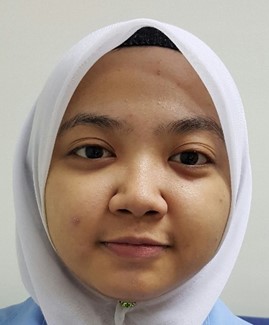 |
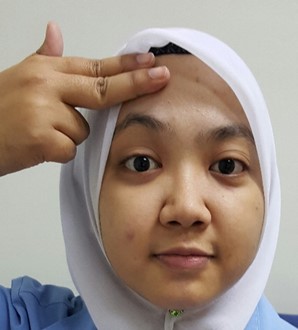 |
|
Sit relaxed in front of a mirror |
Gently raise eyebrows |
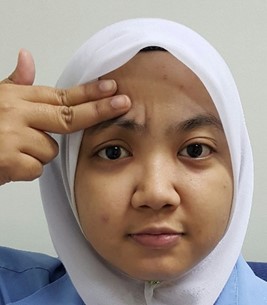 |
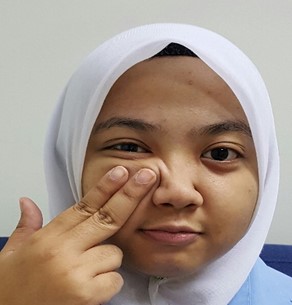 |
|
Draw your eyebrows together, frown |
Wrinkle up your nose |
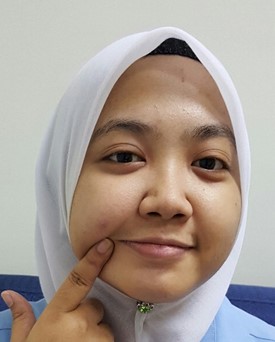 |
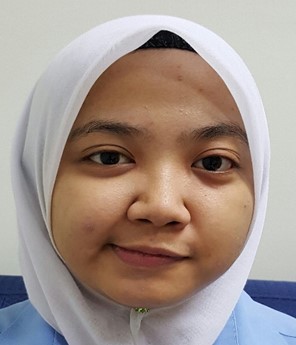 |
|
Gently try and move corners of mouth outwards |
Lift one corner of the mouth |
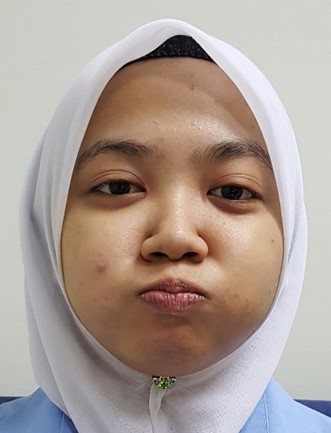 |
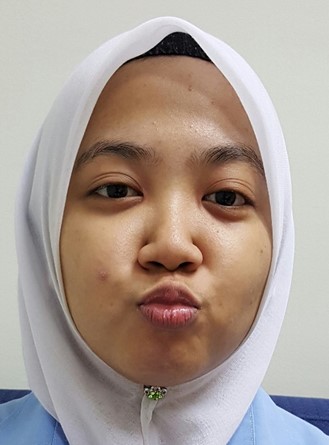 |
|
Fill up your cheek with air |
Bring your lips together and forward |
Source: Image 2015 – Physiotherapy Department, Taiping Hospital.
Exercises To Help Close the Eye
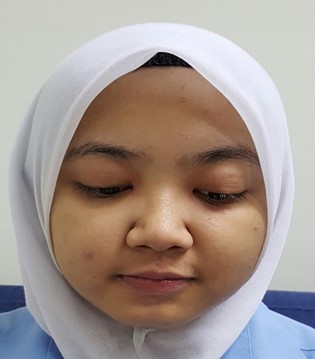 |
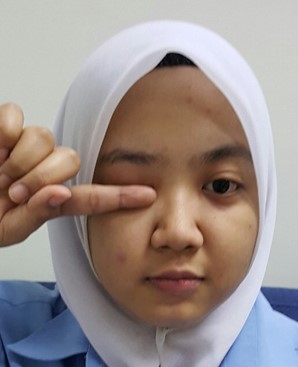 |
|
Look down |
Gently place back of index finger on eyelid, to keep the eye closed |
 |
|
With opposite hand gently stretch eyebrow up…working along the brow line. This will help relax the eyelid and stop it from becoming stiff. |
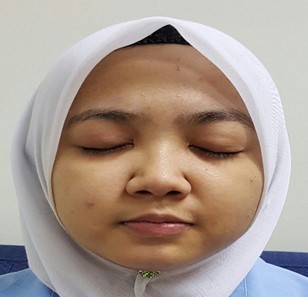 |
 |
|
Close your eyes as much as u can. |
Gently press the eyelids together with your fingers |
Source : Image 2015 – Physiotherapy Department, Taiping Hospital.
Electrical Stimulation
Another method of physiotherapy treatment is using electrical stimulation. Unlike facial exercises which you mostly perform at home, you will need to visit a therapist for electrical stimulation.
Electrical stimulation uses small amounts of electricity to activate the muscles in your face. This causes your muscles to twitch as if electrical impulses from your brain activated them. During the stages of Bell’s Palsy when your face is most paralyzed, this may be the only way for you to activate these facial muscles.
Manual Massage
Massage can be performed in conjunction with other treatment options. It can be done to improve perceptual awareness. Massage manipulations on the face include:
- Effleurage
- Finger or thumb kneading
- Hacking
- Tapping
- Stroking
Other methods of treatments includes ;
- Apply moist heat to the paralyzed area to help reduce pain.
- Try drinking with straw.
- Eat on the side of your mouth that feels most comfortable.
Precaution
The main concern is to ensure the eye is protected and is kept moistened. At night-time, it is probably best to use a soft, surgical, eye patch, taped to ensure the eye remains closed during sleep. Protection from dust and dirt can be achieved by wearing suitable glasses although there is the risk of wind-blown dust and dirt entering the eye.
Eating and especially drinking, can be rather awkward with Bell’s palsy. The only effective method of ensuring that the food / liquid remains in the mouth is to physically hold the affected corner of the mouth closed by holding both lips between thumb and forefinger on the affected side. It may not be particularly attractive or graceful but it is better than wearing what you were trying to eat or drink!
References
- bellspalsy.org.uk The Bell’s Palsy Association
- James M.Elliott, et.all Journal Of Physiotherapy, November 2006 , Vol 34(3) pg 167 – 171
- ncbi.nlm.nih.gov ; Bell’s Palsy. Treatment Guidelines
- bellspalsy.ws/exercise. Bell’s Palsy InfoSite & Forums – Facial Exercises for Bells
- nhs.uk/…/Bells-palsy/Pages/Treatment. Bell’s palsy – Treatment
- patient.info › Health Information. Bell’s Palsy Symptoms. Treatment for Bells Palsy
| Last Reviewed | : | 23 August 2019 |
| Writer/Translator | : | Kogilavani a/p S.Krishnan |
| Accreditor | : | Se To Phui Lin |
| Reviewer | : | Halimah bt. Hashim |







